Paska Easter Bread
Traditional Paska Bread makes a sweet and delightful addition to your Easter table. This easy-to-make sweet bread uses pantry staple ingredients to make a soft and tender loaf of bread. Studded with golden raisins and a braided top, this delicious bread is the perfect addition to your Easter celebrations.
My mom’s side of the family is Italian and that is where I get the majority of my Easter recipes; things like Italian Easter Bread, Pigu, Bacon and Cheese Easter Bread, and Italian Easter Pie. On my dad’s side of the family, my grandmother is Polish and my grandfather was Irish. I don’t know as much about those food traditions, but I’m trying to take the opportunity each year to learn more.
A while ago, my grandma shared this recipe for Paska bread with me. She said she got it years ago from a woman she began chatting with at a department store. They talked about recipes and the woman took down my grandma’s address and said she would send her the family’s Paska recipe. Lo and behold, a few days later, a handwritten recipe showed up in my grandma’s mailbox. As someone who loves to talk about food and share recipes, I just love that story!
What is Paska?
When I first set out to make the recipe I wanted to learn a little more about where it originated and how it’s served.
Paska is a traditional Easter bread from Ukraine and eastern Europe. In Russia, this sweet, eggy bread is called Kulich. It’s most often made in the spring to celebrate Easter. The word Paska translates to “Easter” in most eastern European cultures (except Finland where it’s a 4-letter word).
Traditionally, paska bread is made and taken to church Easter morning to be blessed and then brought home to be enjoyed with Easter meals.
Ingredients for Paska Bread
This Paska bread recipe is a traditional brioche dough recipe, enriched with egg yolks and sugar, then studded with golden raisins and baked up. The raisins are optional and you could definitely omit them if you’d like.
- Whole Milk: The milk gives this bread a softer crust and a rich texture.
- Instant Yeast: Helps the bread rise to towering heights.
- Sugar: Sweetens the bread as well as feeds the yeast to help the dough grow.
- Butter: Gives the dough a softer finish similar to a brioche.
- Eggs: Binds the ingredients together while also lending a little color to this bread.
- Vanilla + Salt: All the flavor!
- Flour: I use all-purpose flour in this recipe.
- Raisins: These add a little sweetness and are totally optional- my mom would omit them!
- Egg wash: Made from mixing an egg with water to glaze the top before baking.
- Coarse sugar: For sprinkling on top, optional but highly recommended.
How to Make Paska Bread
I’m breaking this down into steps to walk you through the process; first, we make the dough, then shape the loaf, and bake the bread. Let’s do it!
Make the Bread Dough
- Activate the yeast: Warm the milk to a temperature between 100°F and 110°F (usually 30 seconds in the microwave should do the trick). Pour the warmed milk into a mixing bowl and sprinkle the yeast over top and let sit for 5 to 10 minutes, until foamy.
- Add liquid ingredients: Add sugar, butter, eggs, and vanilla to the bowl. Stir to combine.
- Make a shaggy dough: Add the flour and the salt into the bowl. Stir with a wooden spoon until a shaggy dough forms. If using, add the golden raisins.
- Knead the dough: Using the dough hook, knead on medium-low speed until a smooth, shiny ball of dough is formed, 3 to 6 minutes, adding additional flour as necessary. (You can also knead by hand until a smooth ball is formed.)
- Let dough rise: Place the dough in a greased bowl and cover with plastic wrap. Place in a warm, draft0free spot until double in size, 1 to 2 hours.
Form and Shape the Dough
- Divide the dough: Punch the dough down and remove it from the bowl to a clean work area. Remove one-quarter of the dough and set aside.
- Shape the base: Form the large piece of dough into a ball and place in a 9-inch round cake pan or a springform pan.
- Braid the dough: Divide the remaining dough into three pieces and roll them each into 20-inch strands. Braid the three strands together for one long braid.
- Top the dough: Divide the braid in half and use it to form a cross over the top of the large ball of dough in the pan. Alternately you can wrap the braid in one length around the inside edge of the pan.
- Allow to rise: Cover lightly with plastic wrap and let rise until puffy and nearly double in size, 45 to 60 minutes.
Bake the Paska Bread
- Set the oven: Preheat the oven to 400°F.
- Make the egg wash: Whisk together the egg and water, then brush evenly all over the top of the dough and sprinkle with sugar.
- Bake the paska: Bake for 15 minutes, then reduce the oven temperature to 350°F and bake for an additional 25 to 30 minutes, until golden brown and an instant-read thermometer registers to 190°F. You can tent the pan with aluminum foil if it is browning too quickly.
- Cool the bread: Remove from the oven, turn the bread out of the pan, and place on a wire rack to cool completely.
Frosting and Glaze
We enjoy this paska bread recipe as is, but if you are looking to sweeten it up even more, try topping the bread with a simple powdered sugar and milk glaze or one of the following:
- Cream cheese frosting
- Vanilla buttercream frosting
- 7 minute frosting
- Orange glaze from my cranberry pound cake
Toppings and Mix-ins
- Traditional topping: Paska is often eaten with hrudka which is a bland, sweet custard similar to cheese.
- Other Toppings: Aside from frosting or a glaze you can top this sweet bread with sprinkles!
- Mix-ins: Chocolate chips, raisins or craisins, or candied fruits mix beautifully in the dough.
Storing, Freezing, Making Ahead
- Storing: Keep cooled paska bread in an air-tight container at room temperature for up to 3 days.
- Freezing: Wrap the cooled paska bread in a tight coat of plastic wrap followed by a layer of foil. Then store in a freezer-safe bag for up to 1 month. Thaw in the fridge overnight.
- Making ahead: You can make this 1 day in advance of serving it, to keep it as fresh as possible. Once cooled, wrap it tightly in two layers of plastic wrap and keep it at room temperature until serving.
- Leftovers: If you don’t want to freeze any of the leftover paska I would suggest slicing and using the bread in French toast or a bread pudding.
Other Delicious Easter Recipes
- Italian Easter Pie Recipe
- Bacon and Cheese Easter Bread
- Italian Easter Bread
- Koulourakia: Greek Easter Cookies
- Tsoureki: Greek Easter Bread
Paska Bread
This Easter, delight your family with a loaf of this sweet Paska Bread. Made with pantry staple ingredients, this raisin studded bread is sure to be a show-stopper! Slather it with butter, a sweet glaze, or homemade icing for a delicious treat!
If you make this Paska Bread recipe and love it, remember to stop back and give it a 5-star rating – it helps others find the recipe! ❤️️
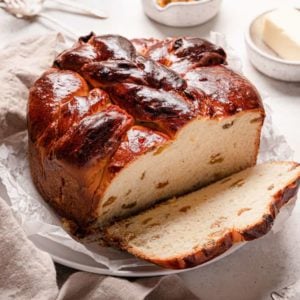
Paska Easter Bread
Ingredients
- 1 cup (240 ml) whole milk, warmed to 110 degrees F
- 2¼ teaspoons (2.25 teaspoons) instant yeast, 0.25-ounce packet
- ½ cup (99 g) granulated sugar
- ¼ cup (57 g) unsalted butter, melted and cooled to room temperature
- 2 eggs
- 1½ teaspoons (1.5 teaspoons) vanilla extract
- 4 cups (480 g) all-purpose flour
- ½ teaspoon (0.5 teaspoon) salt
- 1 cup (160 g) golden raisins, optional
For the Egg Wash:
- 1 egg
- 2 tablespoons water
- Coarse sugar, for sprinkling, optional
Instructions
- Warm the milk to between 100 to 110 degrees F (usually 30 seconds in the microwave does the trick!) and pour into a mixing bowl. Sprinkle the yeast over top and let sit for 5 to 10 minutes, until foamy.
- Add the sugar, butter, eggs, and vanilla extract, and stir to combine.
- Add the flour and the salt and stir with a wooden spoon until a shaggy dough forms. Add the golden raisins then, using the dough hook, knead on medium-low speed until a smooth, shiny ball of dough is formed, 3 to 6 minutes, adding additional flour as necessary. (You can also knead by hand until smooth ball is formed.) Place the dough in a greased bowl and cover with plastic wrap. Place in a warm, draft-free spot until doubled in size, 1 to 2 hours (rise time will depend on temperature and humidity in your kitchen).
- Punch dough down and remove from the bowl to a clean work area. Remove one-quarter of the dough and set aside. Form the large piece of dough into a ball and place in a 9-inch round cake pan or springform pan.
- Divide the remaining piece of dough into three pieces and roll them each out into a 20-inch strand. Braid the three strands together for one long braid. Divide the braid in half and use it to form a cross over the top of the large ball of dough in the pan. (Alternately, you can wrap the braid in one length around the inside edge of the pan.)
- Cover lightly with plastic wrap and let rise until puffy and nearly doubled in size, 45 to 60 minutes.
- Preheat oven to 400 degrees F.
- Whisk together the egg and water, then brush evenly all over the top of the dough and sprinkle with sugar, if desired.
- Bake for 15 minutes, then reduce the oven temperature to 350 degrees F and bake for an additional 25 to 30 minutes, until golden brown and an instant-read thermometer registers 190 degrees F. You can tent the pan with aluminum foil if it is browning too quickly. Remove from the oven, turn the bread out of the pan, and place it on a wire rack to cool completely.
Notes
- Equipment: 9-inch round cake pan or springform pan.
- Golden Raisins: You can substitute regular raisins, other chopped dried fruit, or omit entirely.
- Doubling Recipe: This recipe is easily doubled if you'd like to make two loaves - one for eating and one for gifting (or for your freezer!).
- Storing: Keep cooled paska bread in an air-tight container at room temperature for up to 3 days.
- Freezing: Wrap the cooled paska bread in a tight coat of plastic wrap followed by a layer of foil. Then store in a freezer-safe bag for up to 1 month. Thaw in the fridge overnight.
- Making ahead: You can make this 1 day in advance of serving it, to keep it as fresh as possible. Once cooled, wrap it tightly in two layers of plastic wrap and keep it at room temperature until serving.
- Leftovers: If you don't want to freeze any of the leftover paska I would suggest slicing and using the bread in French toast or a bread pudding.
Did you make this recipe?
Leave a review below, then snap a picture and tag @thebrowneyedbaker on Instagram so I can see it!
Photography by Dee Frances


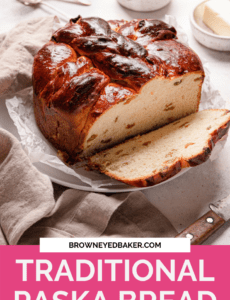
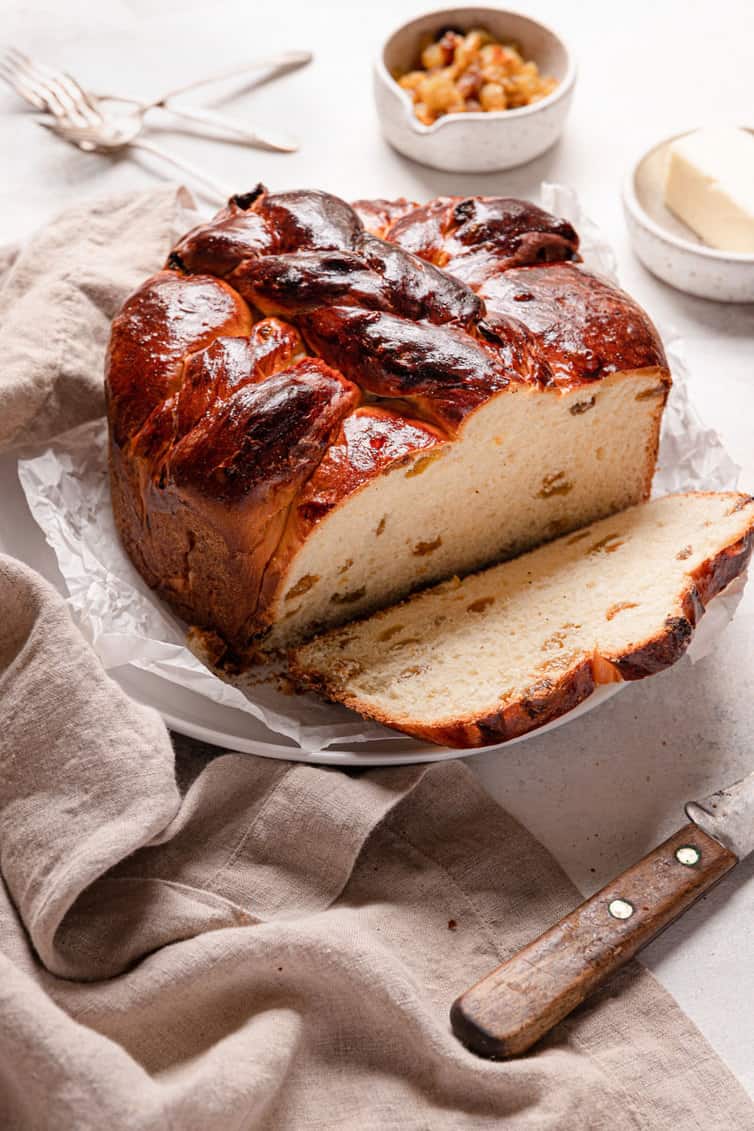
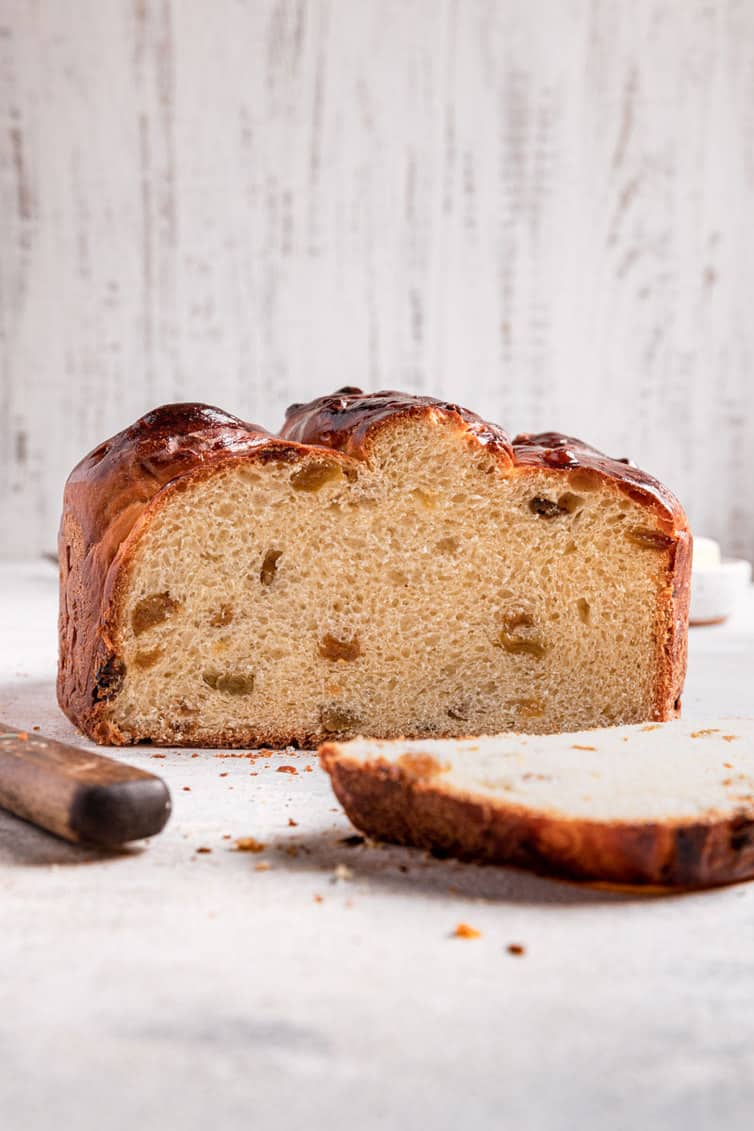
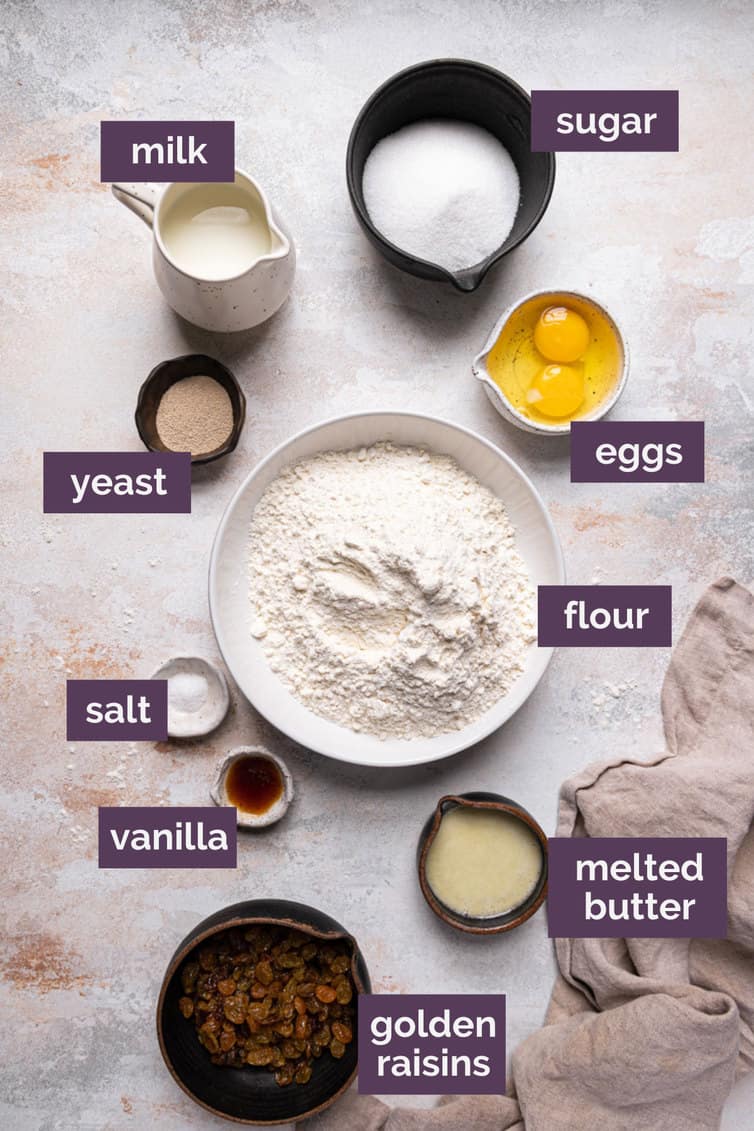
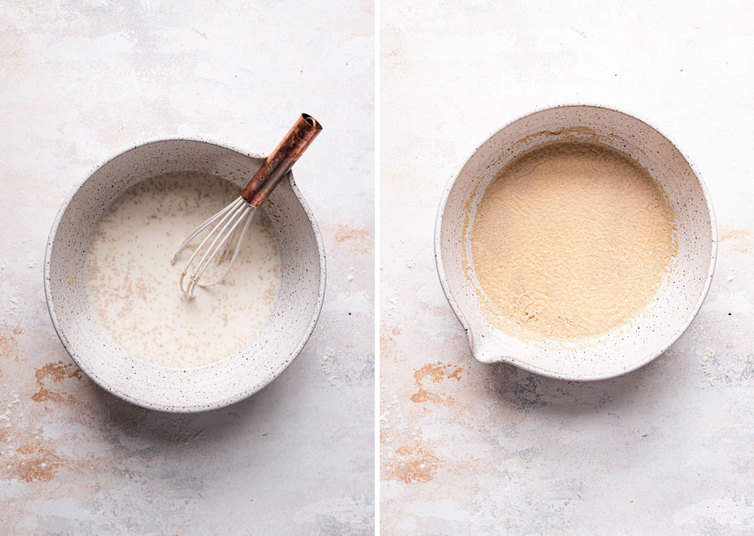
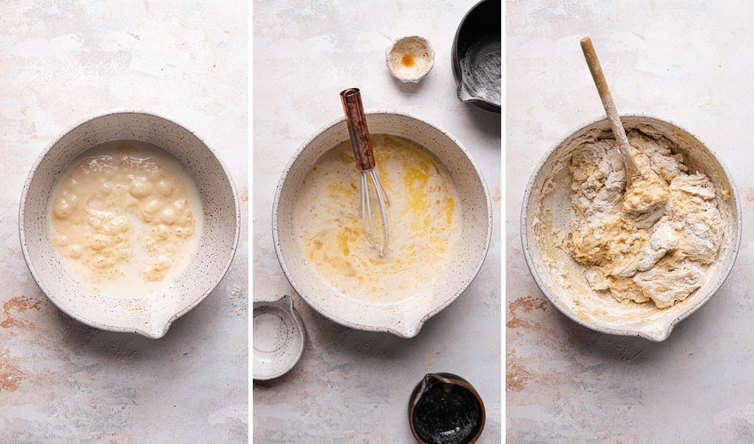
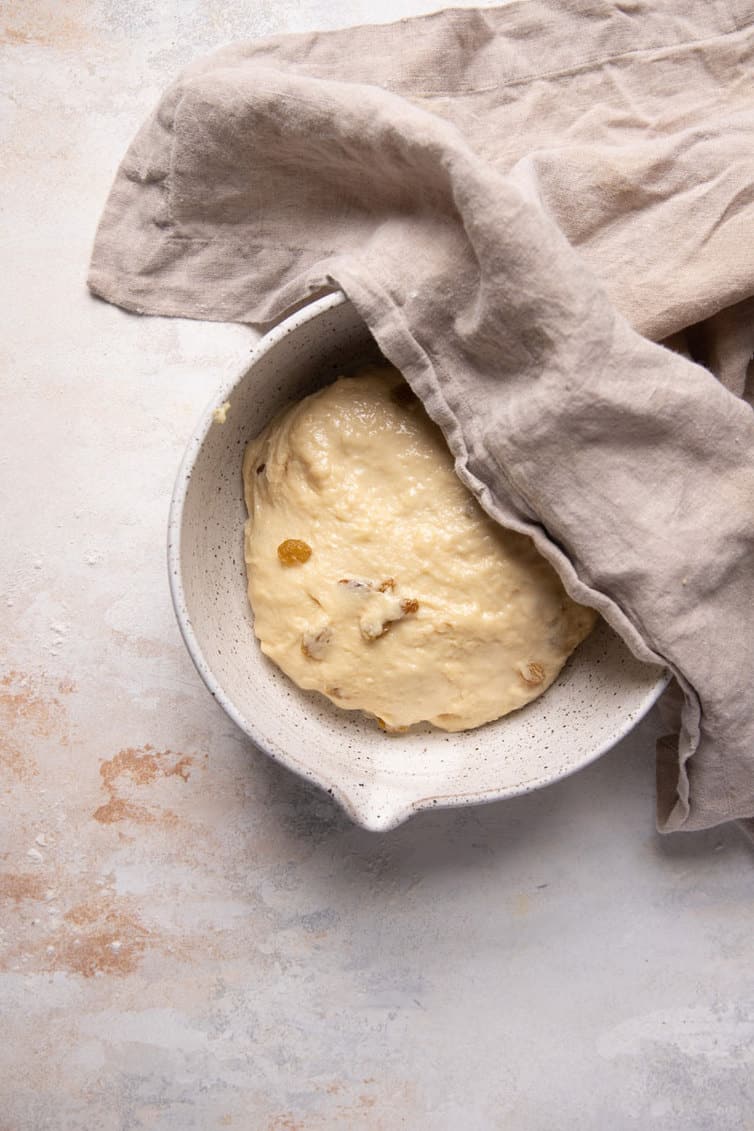
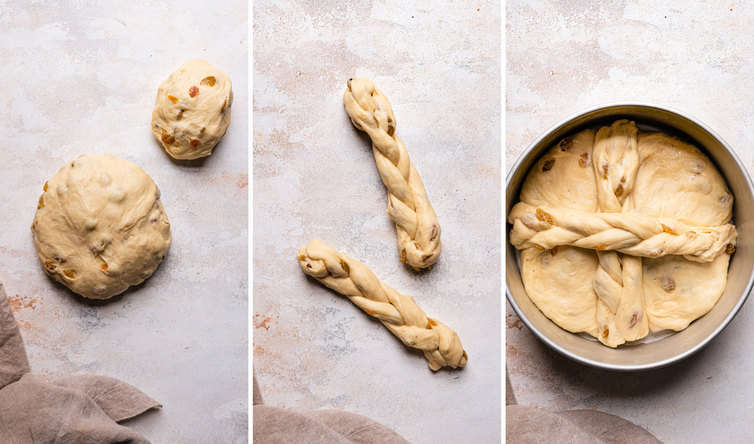
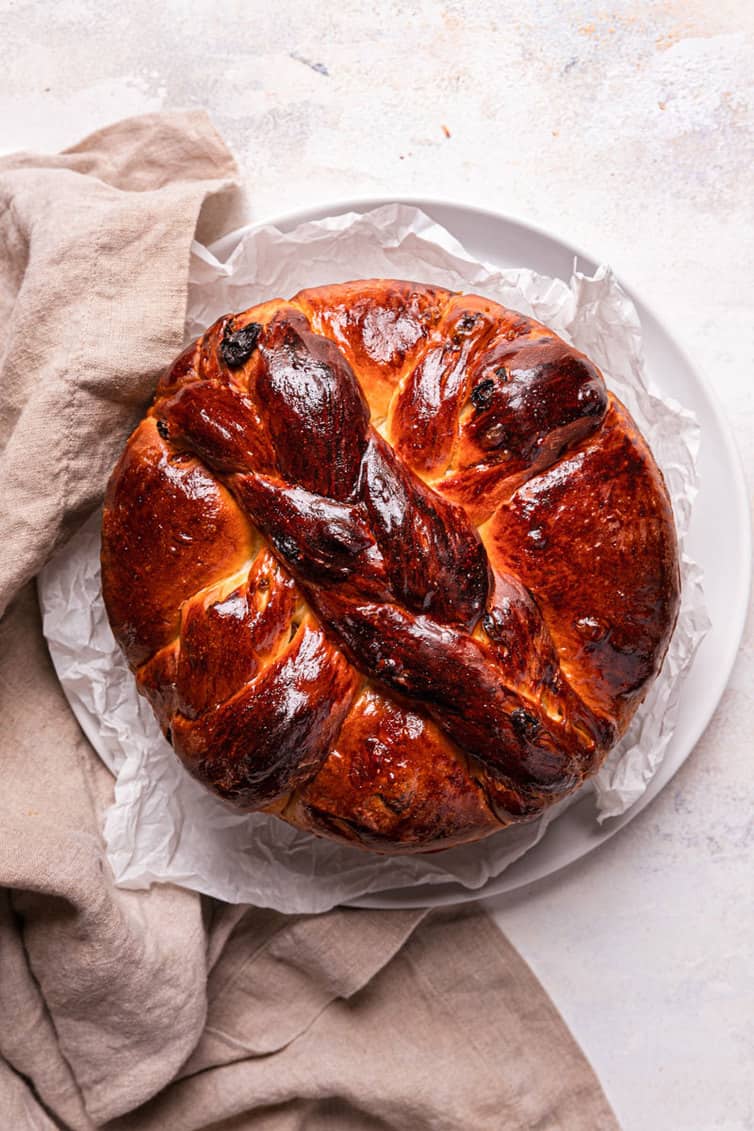
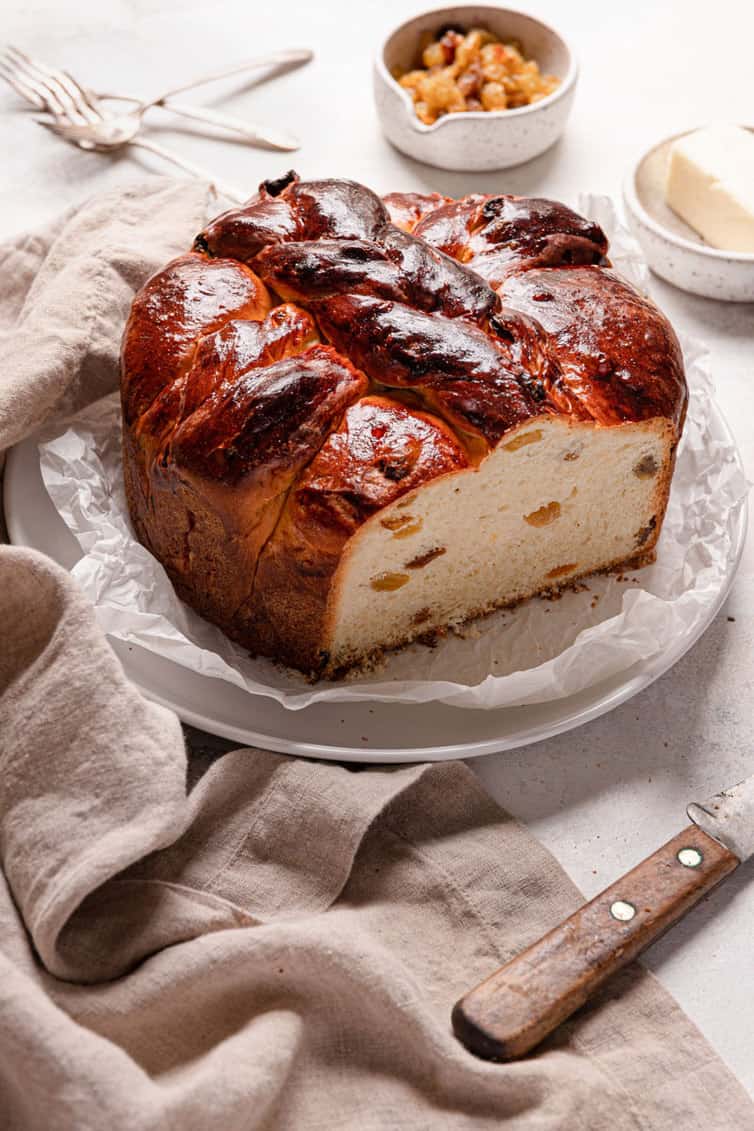



this recipe is stunning and perfect.
my load turned out wonderfully and I can’t wait to make this every year!
I think baking at 400 is too much. Even after turning down to 350 and tenting over dried mine. Other than that, the recipe is tasty.
I love the simplicity of this recipe and it really looks beautiful when its done. But for some reason mine came out too dry– it was crumbling when I tried to cut it into slices. I did only bake it at 400 for 12 minutes and I tented it because it was getting dark at that point. I then lowered the oven temp to 335 for the 25 minutes because I suspected the oven was running too hot. The internal temp was 196 at the finish, so it wasn’t over baked to any huge degree. I suspect this recipe needs a bit more butter or maybe a touch of veg oil? What do you think?
I’ve now made 4 more breads, to share with family & friends after my family polished it off the one I made for Easter! It is really delicious and makes a Beautiful presentation. I did reduce the sugar as most people are already eating too many sweets! No one noticed! Thanks so much for remembering good heart warming foods to celebrate life with, Kathy
Hi, your bread looks beautiful. I would like to make this in a loaf pan. Do you know if it would fit in two loaf pans as written thank you.
I’m not Ukrainian, nor do I celebrate Easter, but sure am glad I stumbled onto this recipe. Mine did require an extra 1/4C of flour, and did rise beautifully in 90 minutes. Used half each brown raisins and dried cranberries.
Every BEB recipe I’ve used is in the faves folder! Thanks, Michelle, for another clearly written delicious recipe.
Can this be made in a regular bread loaf pan?
Thanks Dani
I have my Grandmother’s Babka recipe but prefer yours. I started making your recipe about 7 years ago. My Mom loved it, the bread was moist. I prefer making it in three (3) 8×4 inch loaf pans, 1 for my family and 2 to give to other family members. So glad I printed out your original recipe with the three (3) 8×4 inch pans.
Hi Barbara, I see your post on browneyedbaker’s bread recipe. I’m hoping to make it in loaf pans also. are the ingredients and measurements the same as shown here for the round single loaf? Thank you
The measurements are different. Here is the original recipe.
PASKA BREAD – brown eyed baker.com
2 packs active dry yeast
2 cups whole milk, warmed to 110 degrees
7 to 8 cups all purpose flour
1 cup granulated sugar
1/2 cup unsalted butter, melted and cooled
5 egg yolks lightly beaten
1 teaspoon salt
1 tablespoon vanilla
1 1/2 cups golden raisins
In a large bowl stir yeast into warm milk to dissolve and let sit for 5 minutes. Add 3 cups flour and mix with wooden spoon. Cover bowl with plastic wrap and place in warm, draft free area until dough has doubled in size.
Soak raisins in warm water for 30 minutes and pat dry.
Transfer dough to bowl of electric mixer and add sugar, melted butter, egg yolks, salt, vanilla, golden raisins and 4 cups of flour. Mix on low to medium speed until dough comes together, adding more flour as needed. Turn dough out on lightly floured surface and knead until it forms a smooth dough, about 5 minutes, adding more flour a tablespoon at a time, if needed. Divide the dough into 3 equal pieces and shape into loaves. Transfer to three (3) 8×4 inch greased loaf pans. Cover lightly with plastic wrap and let rise until doubled in size.
Preheat oven to 400 (375 for dark pans). Bake for 10 minutes, then reduce temperature to 350 (325 for dark pans) for an additional 30 – 35 minutes or until loaves are golden brown. If loaves are getting too brown, cover with foil. Allow to cool for 20 minutes then turn pans over on wire rack to cool.
Very good blog post. I absolutely appreciate this site. Keep writing!
Perfect timing! We would always get Paska from the bakery in town- when it went out of business many years later we never found a suitable replacement. This brings back so many memories- thank you!
Your Paska looks beautiful(reminiscent of panettone)! Have you ever made Placek(Polish coffee cake) at Easter? That’s what Polish Buffalonians usually bake and eat at Easter time, and I think that you would enjoy it, too! It is a sweet brioche-type yeast dough scented with vanilla, lemon rind and mace, with golden raisins, baked in a loaf pan, with a generous butter-sugar crumb topping(my mouth is watering just thinking of it). BTW, I love your blog, and I hope that you and your family have a wonderful Easter!!
I’m trying your recipe today for a test. My yeast wasn’t proofing so I added a teaspoon of sugar to it and it proofed perfectly. Hope it turns out as beautifully as yours looks.
First time making paska and I love this recipe. It came out fantastic. My family loved it. My recipe for my Easter paska from now on. Thank you!
Omg this is a great bread. Easy to follow directions and looks just like the picture . Soft inside crusty outside. I used cake pan and did not braid the dough for the top. Tastes great. Will absolutely be making this again. Wont just be Easter Bread might be my go to bread.
What a delicious bread! I used an 8” springform pan and added more baking time. This is an easy recipe to follow,. The texture is soft on the inside and crusty on the outside. Mine looks just like the picture!
I made this today. It got wonderful. Followed recipe. I did have to add 1/2 cup more flour because the dough was too sticky. Will make this again. It tastes fantastic and is so pretty with the braid on it. I did tent it after 15 minutes.
I haven’t tasted this yet, but mine started to get really dark during the 400 degree first 15 minutes. I tented it when I lowered the temperature, but it was already really dark brown. I want to make it again, not so dark, but how would you suggest that I do the temperatures? Maybe 10 minutes at 400 then lower to 350?? It is too hot to cut yet, but we will eat it today and I will try another for Easter. This is a good recipe, but the baking instructions are not working for me. I use an oven thermometer so I know it is accurate. Help Michelle!
Hi Karen, Yes, I would do the 400 degrees for less time, then cover and you may need to bake a little longer at 350. I hope you enjoyed the bread once you sliced into it! :)
Hiiii I made this and it was absolutely gorgeous! Thank you so much. We are a real raisin family so loved it more so.
I wanted to ask if I could bake it on a baking sheet rather than a pan as it got quite big. Also if I add some extra cashews and cranberries into it would I need to adjust anything?
Many thanks x
Hi Sophia, I’m so glad your family loved it! I think baking it free form would work, it would just spread out more, instead of baking “up”. Cashews and cranberries would be delish! No need to change anything (but rise time may take a smidge longer).
Gorgeous recipe! Just one note for everyone, though, paska/Pascha does not translate to “Easter”, it’s literal translation is “passover”. Somewhere down the line when translating the Bible into English, I think it was the King James Version, the translators wanted to differentiate between the Jewish celebration of passover and the Christian feast of Christ’s resurrection (which is Passover fulfilled). In Orthodox communities and the Christian eastern world, Pascha is still the word for this Christian feast, but in the west it is called Easter because that was a word for a celebration of spring time in German (which is where you get all your run of the mill “Easter is really a pagan tradition” rubbish) that they thought would be acceptable so as not to be confused with the Jewish celebration.
Thanks Michelle for sharing these wonderful Easter recipes. Every year at Christmas I use your recipe to make Nut Roll. This year I have two left to serve at Easter. I’ve made your Homemade Peanut Butter eggs — one word – AMAZING.
I’ll definitely be making Paska this year. I was fascinated by the Easter Pie, although I don’t know where in Ohio I could get Basket cheese.
Thanks for all the delicious recipes — I can smell them now!
Do you know where I can get an Italian Easter bread recipe? My grandma Rosa used to do them with the anise oil favoring. They were braided & had colored eggs intertwined in the braiding. They were iced green, white or yellow & had jimmies on top. Her whole house smelled like anise for days after making these. Lol. I’d love to make them in her honor but no one has ever been able to find her recipe. I’m sure it was in her head & there was no recipe written down because thats how she did her whiskey cakes every Christmas. Thank you. Tres :)
Hi Teresa, Yes I have a recipe for Italian Easter Bread! It’s from my husband’s great-grandmother: https://www.browneyedbaker.com/italian-easter-bread-recipe/
Hi! I’m from Poland, and IT’S almost for sure not Polish :) maybe Ukrainiqn or Russian? I think it’s also called more like Pascha there :)
Shouldn’t a tablespoon of sugar be added to the yeast and milk to make it ferment and rise quicker? I am following your recipe and my dough is not rising at all. It’s been a couple of hours already.
I had this same issue with not rising. In my other paska recipe it calls for sugar and it rises with no problems.
We love the taste of this bread. I make it with raisins. The only comment is it doesn’t raise very much, is this normal?
Thank you for posting this recipe. My grandother, who was Russian living in the Ukraine, used to make a bread that looked almost indentical to this, including the golden raisins. I lost the recipe, so I was excited when I saw your post. I’m really looking forward to making this bread!
My grandmother was polish, grandfather Russian. Grandma would make paska but she would bake it in a 2lb coffee can. It came out looking like a big mushroom and was great smeared with butter. I’m going to try this recipe
Was I supposed to follow the yeast packet directions before I mixed it with the milk. The loaves seem to be taking forever to double.
Mine took a lot longer to rise, too. Almost two hours just to begin and a full three hours to double. I think next time I’ll add a bit of sugar to the yeast and milk mixture to get it going. Without the sugar, it didn’t foam at all, and I think that might have been problem. Overall, the bread came out beautifully, it just took a very long time to rise.
My family was Russian and Croatian. My mother always made a recipe I thought was called Pashka (Sp?) It was a cheese mold stuffed with almonds, raisins, cherries, etc.
Recipe
3/4 lb cream cheese
1 stick butter
1/2 cup sour cream
1/2 cup sugar
1 cup chopped almonds
1/2 cup mixed diced candied peels and cherries
1 cup yellow raising
1 enveloped unflavored Geletin
1/4 cup cold water
Mash cream cheese, beat in butter, sour cream and sugar: beat until well blended and creamy. Add almonds, raisins, peels and cherries. Soften gelatin in cold water. Dissolve over hot water bath. Add to cheese mixture and mix well. Turn into a well oiled ring mold or bundt type cake pan. Chill in refrigerator overnight. Put on plate and decorate with additional almond slivers and diced cherries (optional)
Thank you so much for the Eastern European Paska Bread recipe. My Grandmother and Mother always made this bread for the family at Easter and I continued to make it for my family. I lost my my recipe and was in a panic. I am so grateful. Thank you!
Oh you are so welcome Mary! Enjoy!
I’m Polish and from Pittsburgh as well. We always made paska for Easter. My mom would also make loaves in a figure 8 and put the dyed Easter eggs in the holes of the figure 8. I’ve heard of babka too but thought it was the same as paska. Cake yeast is the same yeast that she is talking about on here, or at least that’s what I think, and it’s in the refrigerated section of grocery stores…normally by the butter and eggs..
Thank you for posting this!
Btw, this bread is AWESOME toasted and slathered with butter!!!
I see the raisins are optional, but do you think you could add chocolate mini chips to this bread? It looks delicious!
Hi Karen, I think mini chocolate chips would be delicious!
What about adding saffron to Paska…. always have this in my recipe. It’s expensive but it IS the flavour provider in the Paska. May as well not make Paska without the saffron😯
My Ukrainian mother-in-law from Pittsburgh always used Saffron in her Paska, plus raisins, egg wash etc and braided. After she passed I tried making it multiple times until I thought I had the proportions right. So at Easter Imade it and “presented it” to my father-in-law to taste prior to it being cut for everyone. He officially blessed it as being excellent.
I love this bread, my grandmother would make it every year for Christmas and Easter. She made it well into her 90’s until my mother took over under my Grandmother’s watchful eye. Since Grandma’s passing I have taken over the duty. The bread must be made on Good Friday with Golden raisins, so it is ready for blessing on baskets on Holy Saturday.
How much and or what is the size of a cake of yeast also does this recipe make for a fluffy light bread ?? My previous attempts at paska have produce a more dense loaf .
Thanks
Hi Michelle, One fresh cake yeast is 0.6-ounce. This is definitely a richer, denser bread, not fluffy and light.
Can the pasta bread be made in an angel food pan instead of the 3 loaf pans
Hi Joan, I’ve never made bread in an angel food pan so I couldn’t say for sure how it would turn out.
ABL, I’d like to write a post about real belief in religion and the investiture of same in Tim Tebow. And yes, I want to be the sports writer here at ABL.com. But that’s not important right now. There was quite a marriage of faith in Tebow (maybe understandable) and the Broncos (so God loves the team from Denver? huh?). I’d like to explore this on your site. Are you “game”?
What exactly does your comment have to do with a rating or review of the bread?
Thank you so much for your interest in your families’ traditional foods. The keeper of the kitchen is the cultural transmitter and the symbolism in our eating traditions play an enriching role in our cultural identities. My Polish grandparents came to Canada in the early twentieth century and I missed out on a lot of the Polish food traditions since my mom was of Irish descent, but I am trying now to lay claim to my Polish food heritage and that begins with Easter ! This week I will make your Paska recipe. What I also find interesting is that in both Ireland and in Poland, this herring parade [ beating herrings on a stick at the end of Lent] to commemorate the end of the fish reign, has found its way into both cultures. I won’t be trying that though !
My Danish mother took my Polish grandmothers same recipe and made fried doughnuts covered in dark chocolate or powdered sugar !! Some of the best doughnuts you’ve ever had! There’s a bakery in NYC , Dough , I think, that has very similar ones. Years ago, My sister and I tried but they were sinkers .I’ll stick to making the bread.
This is the same Polish Easter bread recipe my paternal grandmother used to make. I make it every year for my family and neighbors. Only difference is she used one more egg and 1/2 cup less sugar…oh and orange zest. I never knew the real name of it.
We just called it grandma’s Easter bread. Thanks for sharing and Happy Easter !
A lot of folks think I make a babka, but it is different.
( I’m waiting for the dough to rise now )
Hi! This recipe looks much more user-friendly than some other ones I came across. I am Russian, and wanted to try making a paskha for Easter this year. I have never baked a yeasted bread before though, so here is my question: how long does the dough have to rise until it doubles in size? Thanks!!
Hi Margarita, It all depends on how warm/humid your kitchen is, but generally anywhere from 1 to 3 hours.
Tasty bread, but not what I was looking for.; The crumb is fine and heavy…which upon further look is what is pictured in the photos here. I wanted something lighter and a little more bread-like. This is almost like a sweet/quick bread. And there is a lingering aftertaste of the table sugar. I won’t make this one again as I ws looking for a final product that was lighter and less crumbly, but upon retrospect my results are true to the recipe.
This dressing is a winner!! Made it last night and it was delicious! Very versatile, too.
When I originally left a comment I seem to have clicked the -Notify me when new comments are added- checkbox and from now on whenever a comment is added I get four emails with the same comment.
Is there a way you are able to remove me from that service?
Thank you!
My grandma used to make paska, a Russian Mennonite Easter tradition. Hers used quite a few eggs, and was always decorated with white icing and sprinkles. My mom doesn’t really like it, so I decided to take on the tradition now that my grandma is 98 and not baking anymore. I am happy to find a recipe that does not have citrus in it, as many of the ones I have found online do. We don’t add raisins either. Thanks for the recipe!
Thank you for this great recipe. I made a double recipe last weekend. My husband, whose Polish mother used to make wicked babka/paska breads, declared it to be “excellent”. I will make this again!
Michelle, to be traditional, the bread must be round. I use Corning Ware souffle dishes (straight sides), 8″-10″. I have even made it in a cast iron dutch oven for one huge loaf. The recipe is accurate for the slavish/Polish tradition. I grew up with my grandmother’s Easter paska. My grandparents were Polish-Ukrainian. My grandmother would make the paska, sweet poppy seed bread, homemade cheese and butter. My Grandfather would grate the freshly dug horseradish (fiery!) and add some beets to some of it to cut the heat for those who couldn’t take it plain. All of this would go into a gigantic basket along with the ham and kielbasa, with beautiful painted eggs and Easter candles, to take to church Saturday night to be blessed. It was a joyous holiday and holds special memories of my mother’s large happy family. Thanks for sharing this wonderful authentic Polish-Ukrainian recipe. My paska is rising as I write! Happy Easter
Michelle, to be traditional, the bread must be round. I use Corning Ware souffle dishes (straight sides), 8″-10″. I have even made it in a cast iron dutch oven for one huge loaf. The recipe is accurate for the slavish/Polish tradition. I grew up with my grandmother’s Easter paska. My grandparents were Polish-Ukrainian. My grandmother would make the paska, sweet poppy seed bread, homemade cheese and butter. My Grandfather would grate the freshly dug horseradish (fiery!) and add some beets to some of it to cut the heat for those who couldn’t take it plain. All of this would go into a gigantic basket along with the ham and kielbasa, with beautiful painted eggs and Easter candles, to take to church Saturday night to be blessed. It was a joyous holiday and holds special memories of my mother’s large happy family. Thanks for sharing this wonderful authentic Polish-Ukrainian recipe. My paska is rising as I write!
She’s right. My family is Ukrainian and we make this bread for every holiday… we’ve had some trouble finding the perfect round metal dishes to bake them in so we actually use dog bowls (never used by a dog before, of course). They work perfectly.
We also have horseradish with beets in it on our kielbasa!
Use the large metal coffee cans for Paska
I bookmarked this last yr and made it last night. Fantastic! My family has mad a version of this forever but the directions were very spotty. I have never baked with yeast and I needed a recipe! The torch of Paska or as we cAll it, Babka, has now been passed to me :) thanks so much fir this and for all your wonderful recipes! And love your doggies too. Happy Easter!
I’ve found this recipe a year after your post, and it looks like the best one I’ve found! The others hardly resemble paska. I will definitely try it this year. I’m originally from southern Poland near the Slovak border, and we are Roman Catholic. My parents make this every year. I didn’t know that it wasn’t Polish, however (I have always associated it with über-Polski Easter celebrations). I have heard of babka (which is popular in NYC bakeries, for example, and I’ve seen it in patisseries in Québec), but THAT I’ve never had, so the Polish paska vs babka divide must be regional. Interesting comments!
I come from Romania and we eat this on Eastern, but is a kind of pie, with cream cheese and raisins filling, we call is Pasca. it’s not really a bread, more like a sweet treat
Wonderful blog! I found it while searching on Yahoo News.
Do you have any suggestions on how to get listed in Yahoo News?
I’ve been trying for a while but I never seem to get there! Thank you
Ilive in Poland and i never heard abaut Paska bread so i think that it must be Ukrainian or Belarus. In Poland on Easter we often make Pascha (Paskha in english). You can find some information on wiki about it. On christmas traditional we make Chałka (Challah from jewish) also to see in wikipedia.
It’s so refreshing to see how many people are aware of paska bread! I am proud to say my mother kept the traditional Slovak/Polish Easter and Christmas Eve foods. I have many fond memories of making paska with her and the tradition is now passed on to my daughters. My daughter came home for this Easter and I had to wait until today to make my paska with her :)
I wanted to add that we bake our paska bread round and set some of the dough aside and roll 3 pieces to braid for the top of the bread (to represent the crown of thorns Jesus wore on Good Friday). Traditionally the bread was made on Good Friday and Easter baskets were taken to church on Saturday to have the food blessed. Sadly enough it is difficult in the area I live to find a church that stills does this.
I live in Poland and i’ve never heard about that. sounds pretty awesome though, i’ll try it for sure.
Oh my… I love paska bread! This is a family tradition that we do during every holiday! Thanks for sharing the recipe!
I love Paska bread! When I was in high school I worked at a local bakery that always sold Paska bread. However you couldn’t get a loaf until you answered the litany of Paska related questions: large loaf or small, round or square, plain or raisins, sliced or unsliced! All of their breads were terrific and when they closed it was truly a sad day.
sounds and looks alot like what we call babka! I use the base sweet dough to make a nut roll and poppyseed bread, yum :)
tri2cook.blogspot.com/2012/05/poppyseed-bread.html
I have never heard of Paska bread before but so glad to have found it now! Looks like quite a treat.
I have been needing a new bread recipe! I am very excited about this!
I grew up with this Paska bread for Easter. My Grandparents came over from the Ukraine as Mennonite Refugees. The ladies in the village where they came from originally would stack their egg shells on the fence posts as a quiet boast of how rich they were and could add many eggs to their dough. Our Paska is still baked in tin cans so they are cylindrical and have a muffin top. This top is then decorated with icing glaze topped with small jelly eggs, marshmellow rabbits, coconut or whatever is Easterish decor! Every child gets to decorate his own and for their friends! Grandma (92 yrs) has the Great-Grandkids come and bring their Paska for her to decorate! The bread is sliced from the bottom up in circles to be toasted and eaten with butter. It was always too dry to just eat without toasting after the first day out of the oven. BTW: I use 1 TBSP yeast for a Cake.
There is nothing hard about making them and we do some with raisins and without. Try Craisins!
Pinning this to try sometime. Looks amazing! Thanks for sharing!
My husband’s Baba used to make this but also added orange zest – I’m wondering how much to add. Maybe 1/4 cup for whole recipe?
For my Italian Easter Bread (https://www.browneyedbaker.com/2012/04/04/italian-easter-bread-recipe/), which yields about the same amount of dough, I use the zest and juice of 2 oranges.
The texture looks amazing! Everything looks so gorgeous!
Being of Ukrainian descent I appreciate you posting this recipe!! Your Paska looks beautiful!!
Wow, I’m half Polish & half Italian too! I KNEW I liked you! My brother will be thrilled to have this Easter Bread recipe because years ago we tried to make it from a relative’s “hand full of this and spoonful of that” type directions, and we made an Easter brick!
I did the same thing! My Polish Grandma spoke only broken English. Between that and trying to gauge how much flour was in her hands, my attempt failed. It was one heavy brick. I’m looking forward to trying this.
Hi, my maternal grandmother was Polish (off the boat), and my maternal grandfather was of Irish descent (2nd generation) like your dad’s side. I noticed your Italian Easter pie that was traditional to break Easter fast on the Saturday before Easter. The Polish tradition was to not break fast until after Church on Easter Sunday, so we have Easter breakfast/brunch which includes kielbasa, lots of eggs, and baked beans (which I think came from the Irish side of the family). We have a sweet bread tradition – pecan rolls – but I don’t think it has anything to do with Paska, I don’t remember my grandmother making anything like that. Probably my favorite Polish dish – one I crave and have to make every so often is Kapusta.
Such a lovely bread! I love that it’s full of juicy raisins.
I love that you posted this! It’s the bread my grandmother has always made for Christmas and Easter. I’ll be making my batch on Friday. Half the dough becomes poppyseed roll and the other half is made into loaves (usually with a little dough-cross pressed into the top of each one for Easter). I love that you use the golden raisins, just like we do – regular raisins just aren’t the same in this bread!
Looks fantastic.. nice clicks too !!
My grandmother was Polish, and she made a holiday bread that was very similar for both Christmas and Easter. Our family just called it “homemade bread,” and I haven’t come across the name paska, although I’ve tried to uncover the origins of her recipe. Fortunately, my aunt wrote up a recipe while my grandmother was still alive, and I recently simplified or “modernized” it if you will by making it more precise. When the women in my family have tried to make it in the past, they’ve had to cross fingers and pray for good results because the bread was always a 50-50 chance of success. One funny thing is that my grandma’s recipe also called for the “cake” type yeast which I never find. And, my grandma was from Pittsburgh btw. Anyway, here’s a link to my version of her bread:
http://www.aminglingoftastes.com/2012/12/polish-holiday-sweet-bread.html
Aw, I love it! Thanks for sharing your link!
My polish grandmother makes this every year! I always request a loaf (or two) to take home with me. I can’t get enough. I might attempt this recipe to see how it compares to hers. Thanks for sharing!
absolutely gorgeous bread!
Yummy! I wlll try this. But like the other ladies – I was wondering about the 2 cakes of yeast?? And what would the substitute be??
Hi Lianne, Cakes of yeast is the fresh version of yeast and usually found in the refrigerated section of the supermarket. I have the measurements in the ingredient list above for substituting active dry yeast.
Wow, this bread looks amazing, and reading the ingredients list, it has to be good! I love the sunny, brightness that the golden raisins give it.
My father-in-law is Polish and I know he would love it if I made him this bread. Thanks for the recipe, Michelle!
My grandmother who was from Poland made this every year. She always made a few loaves and took one to be blessed in the Easter basket on Holy Saturday. Thanks for posting and bringing back some good memories. I may try to make the bread for Easter Sunday.
My Busia (Polish for grandmother)use to make a variation of this recipe. The problem was…she did not have a recipe. She made all her breads and pastries by “feel” and they always tasted amazing! Cannot wait to try this recipe!
I would hide myself away with a loaf of this bread and a stick of cold, sweet butter.
Definitely Eastern European/Orthodox.
Thanks for the recipe. My husband is Orthodox and I may just be nice enough to make him Paska for Easter since there is no way any bakery will have it on May 5th which is Orthodox Easter this year.
I asked my dear friend Joanna, who is originally from Poland, and she said that they make something similar in a bundt cake pan and call it “babka”, and they coat it in confectioner’s sugar.
This looks delicious.
What is 2 cakes fresh yeast? What would I substitute and where can I buy it?
Yeast comes in three forms – fresh (called cakes), active dry and instant. The fresh yeast is sold in the refrigerated section of most supermarkets. See the ingredient list above for the active dry substitution.
May i know what is 2 cakes fresh yeast?
And you mentioned substitute 200ml warm milk and yeast -> how much yeast to add?
Thanks :)
Haopy Easter Holidays!
Fresh yeast is a type of yeast (vs. active dry or instant) and can be found in the refrigerated section of the supermarket. You don’t substitute milk for the yeast; milk is part of the ingredients of the recipe. See the ingredient list above for the active dry yeast substitution.
My Husband is Polish. I have to ask him about this bread, if he knows it. I might make it for him as a surprise this weekend! Thank you for sharing!
Wow! I’m Polish and I’ve never had this sort of bread on Easter. Google shows me that it’s a regional dish made predominantly in the Eastern provinces, especially in the Orthodox communities (the fact that it doesn’t have a Polish wikipedia entry is a bit telling). It’s definitely more of a Russian/Ukrainian specialty. The majority of Poles celebrate Easter with a yeast babka (which is more or less the same dough as paska, but baked in a bundt pan), or mazurek, or cheesecake, or maybe even a paskha (a tasty dessert made of curd cheese, sugar, vanilla, yolks, nuts, and all sorts of dried fruit and mixed peel). Paskha-the-dessert has Russian origins too, but somehow it gained much more popularity than paska-the-bread ;)
I got my recipe from my mother-in-law whose mother was directly from Poland – what area I am not sure. Mine is made the bread then there is a cheese “dough” that include yeast and flour and strong Cheddar cheese rolled into the bread dough – we love this. Instant cheese sandwich or better yet a delightful ham and cheese sandwich – anyone else have this type ??
Thanks Michelle. I may try this and let you know. I grew up with this type of babka that my grandma’s neighbor used to make for Easter. Although they were shaped like a stand up cylinder.
Saw your comment about stand up cylinders. I had to laugh. My Grandmother used coffee cans too!
We call it Kulich where I’m from but regardless, there really are few things that compare to kulich (babka) for a Russian Easter celebration! A cylinder shape is almost mandatory in my household after watching ‘Gran and ‘Ma make these for so long in their bakery and seeing so many of the familiar cylinder-cakes in the stores, but I suppose if there’s no clean cans available a breadpan would totally work out.
I personally love a tiny bit of orange peel and some cardamom mixed in with mine, it brings things together so nicely. Put the dough in a well greased and floured coffee can and let heaven bake while getting some nice vanilla glaze ready.
Something that is really good to do is to soak some golden raisins in spiced rum with a touch of vanilla before folding them in the batter, it really brings out some nice flavors with the orange flavors. Craisins were also used to wonderful effect after a soaking in Triple Sec liqueur.
I Love bread!1 Of all kinds! This one is no exception, it looks so soft! With butter, right out of the oven, mmmm…!
Just one thing, how much is a cake of yeast?
In Portugal we have a traditionnal Easter bread called Folar de Páscoa, flavored with cinnamon and anise, and decorated with hard boiled eggs.
Hi Teresa, Cakes of yeast are sold in the refrigerated section of the supermarket. I believe they are 2 ounces.
I love golden raisins and this bread looks like something my Russian-Polish grandmother used to make! Love the story how you came to obtain the recipe!